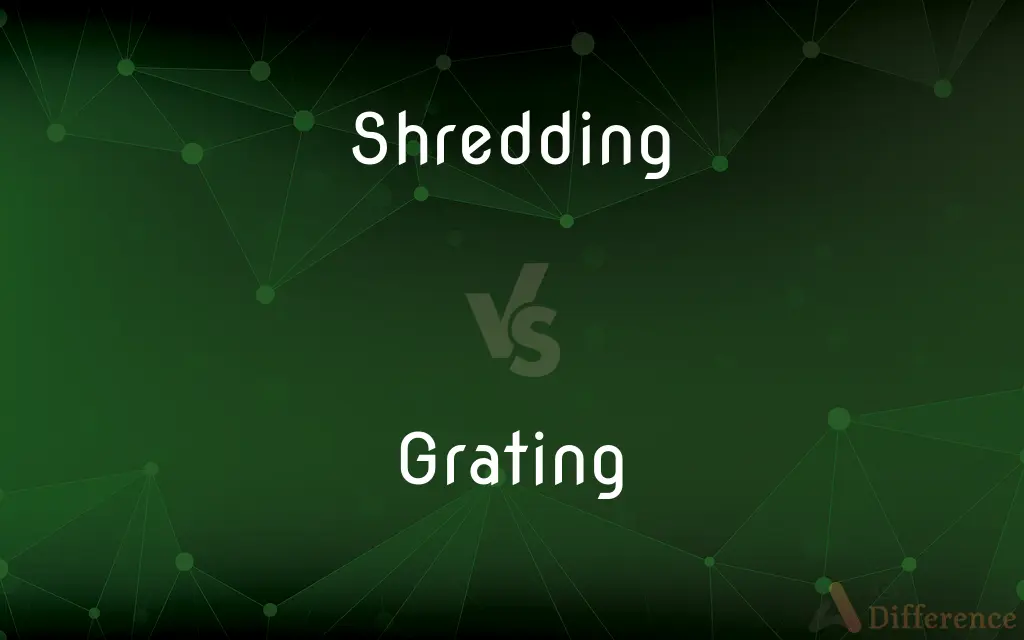Shredding vs. Grating — What's the Difference?
By Tayyaba Rehman & Urooj Arif — Updated on April 21, 2024
Shredding creates longer, thinner strips of food, typically using a shredder; grating produces finer, smaller pieces with a grater, often used for cheese or vegetables.

Difference Between Shredding and Grating
Table of Contents
ADVERTISEMENT
Key Differences
Shredding involves cutting food into long, thin strips, ideal for salads or sandwiches, using tools like a box shredder or a food processor. Whereas, grating breaks down food into smaller, often powdery pieces, useful for baking and cooking, using a grater or microplane.
Shredders usually have larger holes than graters, resulting in thicker, more substantial pieces of food. On the other hand, graters typically have smaller, more numerous holes that produce finer shreds, suitable for melting or blending into recipes.
The technique of shredding is often applied to vegetables like cabbage or cheese that need to retain some texture and bite in dishes such as coleslaw or tacos. Conversely, grating is favored for items like hard cheeses or spices, where a fine texture is desirable for even distribution within a dish.
In terms of equipment, shredders can be standalone tools or attachments for kitchen appliances and are generally more robust. On the other hand, graters can range from simple handheld tools to more complex rotary graters, often requiring less storage space.
Shredding is less labor-intensive compared to grating; the latter often requires more effort and time, especially when dealing with hard items like nutmeg or Parmesan cheese.
ADVERTISEMENT
Comparison Chart
Texture
Coarse, longer strips
Fine, powdery particles
Tools
Shredders, food processors
Graters, microplanes
Common Uses
Vegetables for salads, cheese for tacos
Cheese for pizza, spices for cooking
Effort
Generally easier, less time-consuming
More labor-intensive, especially for hard foods
End Result
Retains more texture, less uniform
More uniform, blends easily into dishes
Compare with Definitions
Shredding
The act of tearing something into strips.
Shredding documents ensures privacy and security.
Grating
Rubbing food against a grater to create fine particles.
Grating garlic into a dressing disperses its flavor more effectively.
Shredding
Often associated with preparing ingredients that are eaten raw or lightly cooked.
Shredding radishes for a taco topping adds a peppery snap.
Grating
A culinary technique for enhancing flavor distribution.
Grating nutmeg into eggnog spices it up nicely.
Shredding
A method used in culinary preparations to enhance ingredient texture.
Shredding chicken for burritos distributes it evenly.
Grating
Used commonly for integrating ingredients smoothly in cooking.
Grating Parmesan on pasta melts quickly for a creamy texture.
Shredding
Cutting food into long, thin strips using a shredder.
Shredding carrots for a carrot salad enhances their flavor and texture.
Grating
The process of transforming solid food items into finer pieces.
Grating chocolate over a cake decorates it beautifully.
Shredding
A technique to prepare vegetables or cheese in cooking.
Shredding lettuce for a burger adds a crunchy texture.
Grating
Essential for achieving a powdery consistency from hard foods.
Grating a cinnamon stick for fresh powder is ideal for baking.
Shredding
A long irregular strip that is cut or torn off.
Grating
A grating is any regularly spaced collection of essentially identical, parallel, elongated elements. Gratings usually consist of a single set of elongated elements, but can consist of two sets, in which case the second set is usually perpendicular to the first (as illustrated).
Shredding
A small amount; a particle
Not a shred of evidence.
Grating
A grill or network of bars set in a window or door or used as a partition; a grate.
Shredding
To cut or tear into shreds.
Grating
A diffraction grating.
Shredding
To use a mechanical shredder to shred (paper documents, for example).
Grating
(typically of a voice) Harsh and unpleasant.
Shredding
To make a series of quick turns on a wave or snow, for example, when riding a board such as a surfboard or snowboard.
Grating
Abrasive; tending to annoy.
Shredding
To play fast solos accompanied by special techniques on the electric guitar.
Grating
A barrier that has parallel or crossed bars blocking a passage but admitting air.
Shredding
The act of cutting or tearing into shreds.
Grating
A frame of iron bars to hold a fire.
Shredding
That which is cut or torn off; a piece.
Grating
The loose material that comes from something being grated.
Add a few gratings of nutmeg to the hot milk.
Shredding
A style of very fast and very complex guitar playing.
Grating
An optical system of close equidistant and parallel lines or bars, especially lines ruled on a polished surface, used for producing spectra by diffraction.
Shredding
Present participle of shred
Grating
The strong wooden lattice used to cover a hatch, admitting light and air; also, a movable lattice used for the flooring of boats.
Shredding
The act of cutting or tearing into shreds.
Grating
The sound made by something that grates against something else.
Shredding
That which is cut or torn off; a piece.
Grating
Present participle of grate
Grating
A partition, covering, or frame of parallel or cross bars; a latticework resembling a window grate; as, the grating of a prison or convent.
Grating
A system of close equidistant parallel lines or bars, esp. lines ruled on a polished surface, used for producing spectra by diffraction; - called also diffraction grating.
Grating
The strong wooden lattice used to cover a hatch, admitting light and air; also, a movable Lattice used for the flooring of boats.
Grating
A harsh sound caused by attrition.
Grating
That grates; making a harsh sound; harsh.
Grating
A barrier that has parallel or crossed bars blocking a passage but admitting air
Grating
A frame of iron bars to hold a fire
Grating
Optical device consisting of a surface with many parallel grooves in it; disperses a beam of light (or other electromagnetic radiation) into its wavelengths to produce its spectrum
Grating
Unpleasantly harsh or grating in sound;
A gravelly voice
Common Curiosities
Which is quicker, shredding or grating?
Shredding is usually quicker as it requires less effort to push food through larger holes compared to the finer holes of a grater.
Can you use a grater to shred?
While a grater can be used for a form of shredding, it typically produces finer pieces than a dedicated shredder.
What tools are best for grating hard cheese?
A box grater or a microplane is ideal for grating hard cheese, providing fine particles that melt easily.
What is shredding used for in cooking?
Shredding is used to prepare vegetables or cheese in a form that is textural yet thin enough to cook quickly or eat raw.
Is grating suitable for soft foods?
Grating is generally more challenging with soft foods, which may mush or stick to the grater.
Are there electric tools for shredding and grating?
Yes, there are electric shredders and graters available that automate the process and reduce manual effort.
What materials are shredders and graters made from?
They are typically made from metals like stainless steel for durability and ease of cleaning.
What is the best grater for spices?
A microplane grater is best for spices, as it can finely grate hard spices like nutmeg or cinnamon.
How do I choose between shredding and grating for a recipe?
Consider the desired texture and distribution of the ingredient in the dish; use shredding for larger, more textured pieces and grating for finer, more blended results.
What's the easiest way to clean a grater after use?
Cleaning a grater is easiest immediately after use, using a brush to remove remnants under running water.
Can I shred meat?
Yes, meat can be shredded, especially after cooking, to make it easier to distribute in dishes like sandwiches or tacos.
Why is shredding preferred for coleslaw?
Shredding is preferred for coleslaw to achieve a crunchy texture that holds up well with dressing.
How do I prevent injuries while using a grater?
Use a guard or glove to protect fingers and keep the grater stable on a flat surface.
What is a rotary grater used for?
A rotary grater is used to grate large amounts of cheese or vegetables quickly and with less risk of injury.
Can grating make ingredients too fine for some recipes?
Yes, overly fine ingredients from grating can sometimes blend too much into the background of a dish, losing intended textures.
Share Your Discovery

Previous Comparison
Simile vs. Metaphor
Next Comparison
Laze vs. LaseAuthor Spotlight
Written by
Tayyaba RehmanTayyaba Rehman is a distinguished writer, currently serving as a primary contributor to askdifference.com. As a researcher in semantics and etymology, Tayyaba's passion for the complexity of languages and their distinctions has found a perfect home on the platform. Tayyaba delves into the intricacies of language, distinguishing between commonly confused words and phrases, thereby providing clarity for readers worldwide.
Co-written by
Urooj ArifUrooj is a skilled content writer at Ask Difference, known for her exceptional ability to simplify complex topics into engaging and informative content. With a passion for research and a flair for clear, concise writing, she consistently delivers articles that resonate with our diverse audience.














































